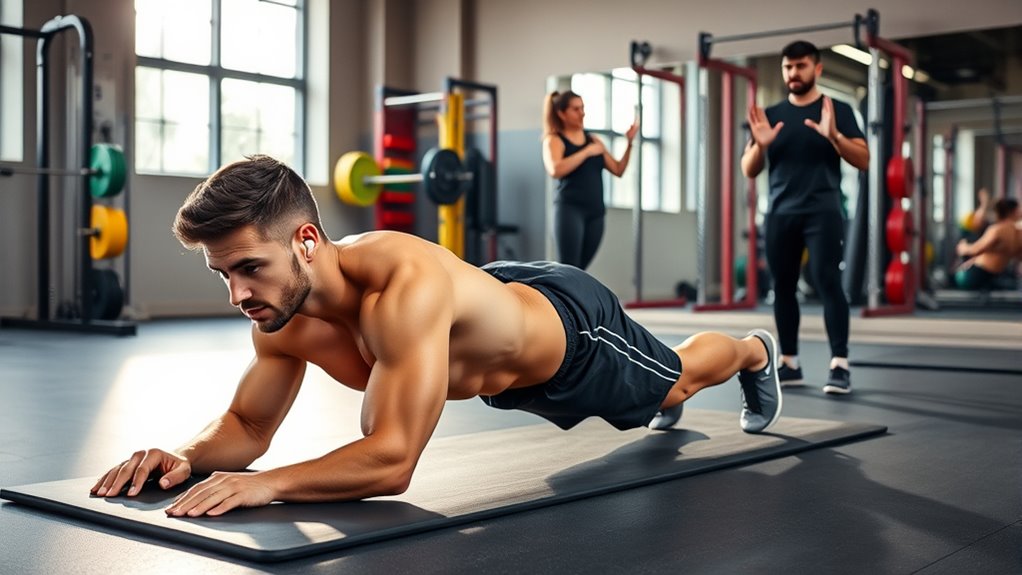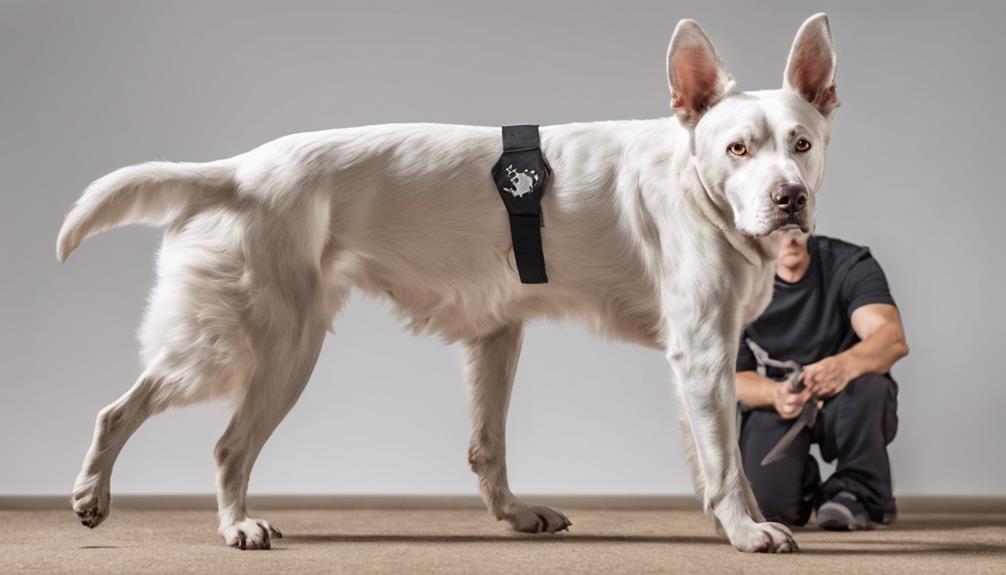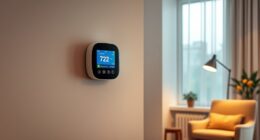To improve your fitness routine, focus on clear visual communication by using demonstrations, gestures, and visual aids. Choose well-lit, quiet spaces with good sightlines to see instructors or videos clearly. Use technology like hearing aids, fitness trackers, or captioning apps to stay informed and safe. Opt for activities like yoga or Pilates that emphasize visual cues, and foster a supportive community. Keep exploring these strategies to make your workouts safer, more engaging, and fully inclusive.
Key Takeaways
- Use visual demonstrations, gestures, and written instructions to ensure clear communication during workouts.
- Choose well-lit, quiet environments with minimal background noise to enhance lip-reading and visual cues.
- Incorporate technology like captioning apps and connect hearing aids with fitness trackers for safety and awareness.
- Engage in activities like yoga or Pilates that rely on visual cues and demonstrations for better understanding.
- Train staff in deaf awareness and utilize visual signals to create an inclusive, supportive fitness community.
Communicating Effectively During Workouts

To communicate effectively during workouts, it’s important to face the deaf individual directly and maintain eye contact. This helps facilitate lip-reading and guarantees your communication is clear. Use visual cues, gestures, and demonstrations to explain exercises and give instructions; these methods support understanding without relying solely on spoken words. Speak slowly and clearly, avoiding mumbling, so your lip movements are easy to see. Incorporate written instructions, visual aids, or digital displays to reinforce verbal communication, especially when clarity is essential. Regularly check for understanding by observing responses and asking for confirmation. This approach helps ensure your instructions are understood and promotes a smooth, effective workout experience for deaf individuals. Additionally, understanding family dynamics, such as cultural heritage or upbringing, can enhance your ability to tailor communication strategies effectively. Recognizing the importance of effective communication techniques can improve overall interaction and trust during exercise sessions. Developing trust and rapport is crucial for creating a supportive environment where the individual feels comfortable and motivated. Data privacy concerns highlight the importance of clear communication about how information is shared and used during interactions. Being aware of environmental considerations, like noise levels or lighting, can also improve communication effectiveness. Clear, direct communication builds confidence and trust during exercise sessions.
Incorporating Visual Cues and Demonstrations
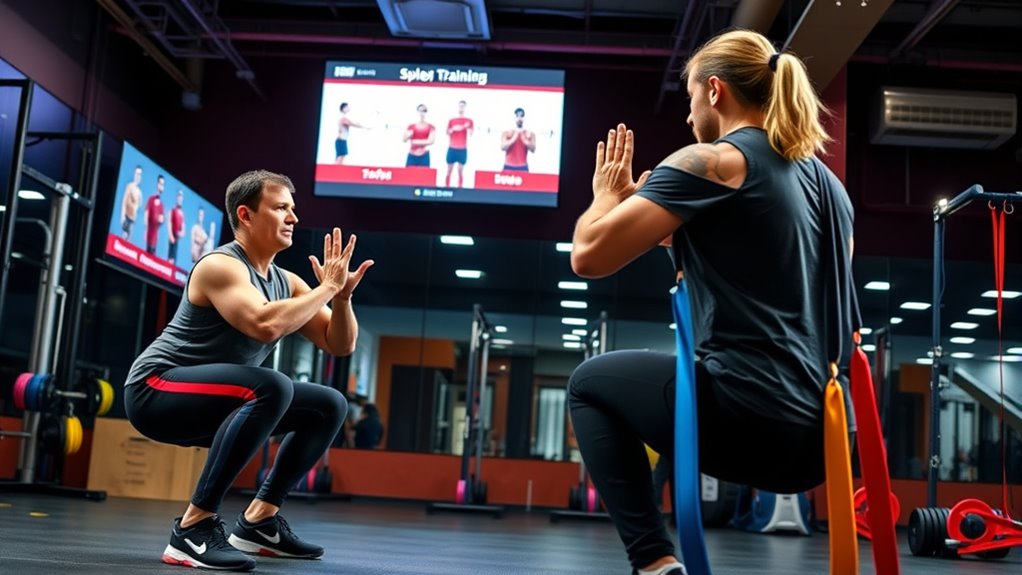
To effectively teach fitness, use clear and exaggerated demonstrations of exercises so you can easily show proper form. Incorporate visual aids like diagrams or gestures to clarify instructions, and always maintain eye contact to guarantee understanding. Position yourself directly in front of the individual to facilitate lip-reading and keep visual cues consistent throughout the workout. Using animated movies that touch hearts can also inspire motivation and emotional connection during training sessions. Additionally, being aware of local store hours can help in scheduling sessions without interruptions. Incorporating knowledge about home theatre projectors, such as selecting the right projector type or understanding image quality factors like contrast ratio, can also provide engaging visual content to demonstrate exercises more effectively. Developing leadership skills such as clear communication and strategic planning can enhance your ability to motivate and instruct clients effectively. Being familiar with best beaches and their scenic features can offer calming backgrounds or inspiration for outdoor workout sessions.
Use Clear Demonstrations
Using clear demonstrations is essential for effective communication during exercise sessions with deaf individuals. Visual demonstrations help bridge communication barriers, making it easier to understand movements and techniques.
When you show exercises, do so slowly and deliberately, so participants can observe proper form and technique. Use clear hand signals and expressive body language to reinforce instructions and clarify key points. Incorporate visual cues like arrows, diagrams, or videos to illustrate complex movements or sequences, ensuring they’re visible from all angles. Emphasize important details through visual emphasis to boost retention. Additionally, utilizing visual learning resources can enhance understanding and engagement for deaf individuals. Being aware of asset division strategies can also help in planning personalized programs that meet individual needs effectively. Incorporating visual aids such as charts or demonstrations can further improve comprehension during exercises. Employing multisensory approaches can also cater to different learning preferences and reinforce skill acquisition.
Incorporate Visual Aids
Incorporating visual aids like clear demonstrations, hand signals, and diagrams substantially improves understanding for deaf individuals during workouts. Use visual cues such as written instructions, diagrams, and exercise demonstrations to reinforce your technique. Guarantee all demonstration videos or images are well-lit and visible, so you can easily follow the movements. Visual timers or countdowns help you track exercise durations and progressions without needing verbal prompts. Position yourself so you can see the instructor and visual aids at all times. To imagine this setup:
| Visual Aid Type | Purpose |
|---|---|
| Exercise demonstration | Show proper form clearly |
| Hand signals | Communicate cues quickly |
| Written instructions | Provide detailed guidance |
| Diagrams | Visualize complex movements |
| Visual timers | Track time without verbal cues |
Engaging with visual aids effectively can also boost motivation and confidence during workouts. Being aware of pinball machine weights can help you plan safe transportation and setup, especially if you are moving or installing equipment at home. Additionally, understanding safe food options for dogs ensures that pet nutrition remains healthy and safe, which can be part of your overall wellness routine. Incorporating visual cues into your routine not only makes exercises more accessible but also enhances overall safety and effectiveness. Incorporating a variety of visual learning methods can further improve your comprehension and retention of exercise techniques.
Maintain Eye Contact
Maintaining eye contact during workouts is essential for effective communication with deaf individuals, especially when paired with visual cues and demonstrations. Eye contact allows you to read facial expressions and lip movements, making instructions clearer. It also helps you guarantee that your message is understood without relying solely on verbal cues. Incorporating visual cues and demonstrations further enhances comprehension and safety. Using visual demonstrations alongside eye contact increases comprehension and keeps participants safe, especially during complex exercises. Additionally, consistent eye contact fosters a connection that boosts confidence and motivation, encouraging active participation. Recognizing the importance of digital literacy can also assist in using technology effectively to support communication. Developing inclusive communication strategies ensures that all participants can engage fully and feel supported during workouts. Being aware of self watering plant pots can serve as a metaphor for maintaining consistent and reliable communication practices. Implementing sound healing science principles, such as the strategic use of visual and vibrational cues, can further improve engagement and understanding in diverse workout settings.
Selecting Appropriate and Adapted Exercise Environments
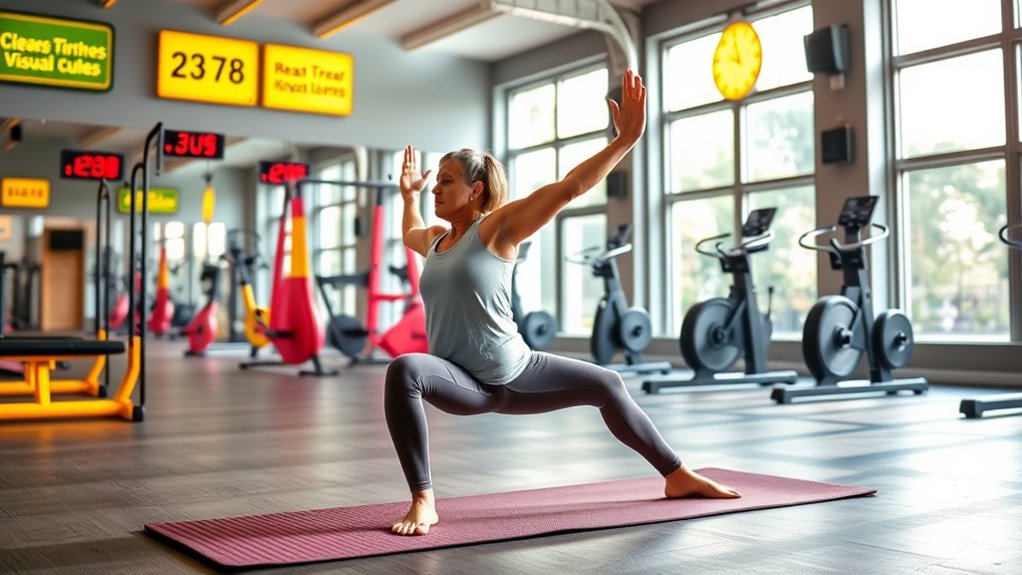
Choosing the right exercise environment is essential for deaf individuals to communicate effectively and stay engaged. An ideal setting features good lighting, minimal background noise, and clear sightlines, making visual communication easier.
Look for outdoor or well-structured indoor spaces that facilitate lip-reading and visual cues from trainers or peers. Supportive facilities, such as accessible signage, visual aids, and designated demonstration areas, enhance understanding and safety.
Avoid noisy gyms or places with loud equipment that can hinder communication and cause fatigue. Choose environments that provide enough space for gestures, visual cues, and adaptive communication tools.
Prioritizing these factors helps you stay connected, participate fully, and enjoy your workout without unnecessary barriers. Your exercise environment should empower your fitness journey, not limit it.
Choosing Inclusive and Supportive Fitness Activities
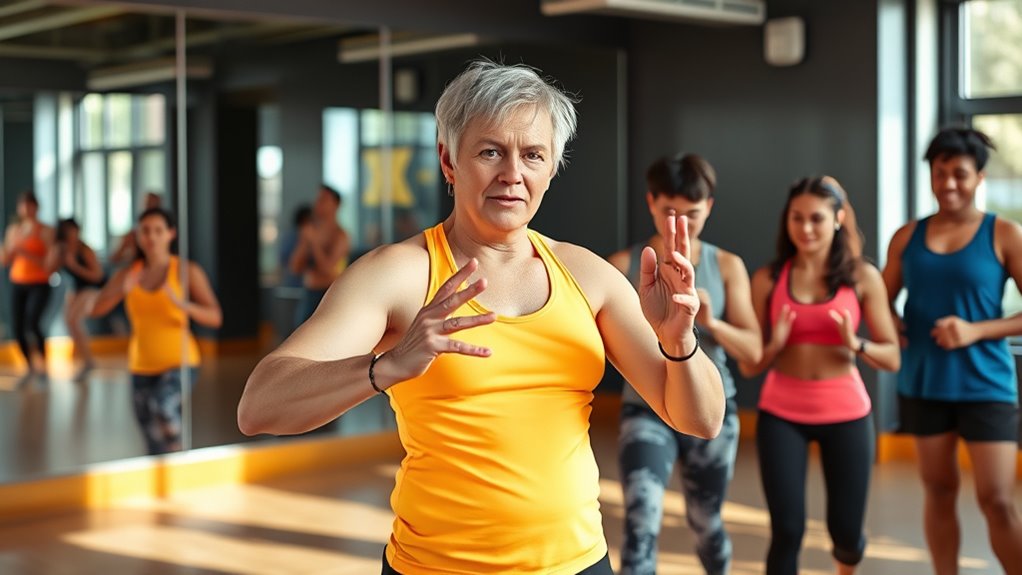
Selecting fitness activities that are accessible and supportive can make a significant difference in your workout experience. Look for inclusive options that emphasize visual communication, such as yoga or Pilates, which rely on demonstrations and visual cues, making instructions easier to follow.
Group exercises where instructors face participants and use clear visual signals help facilitate lip-reading and visual understanding. Choose adapted activities with minimal background noise and loud equipment to reduce distractions and enhance focus.
Prioritize programs that offer written or visual instructions alongside verbal cues, accommodating various communication needs. Activities that promote social interaction through visual engagement, like team sports with visual signals or sign language support, can boost your confidence and enjoyment.
Finding these inclusive and adapted activities helps create a positive, effective fitness routine.
Using Technology to Enhance Engagement and Safety
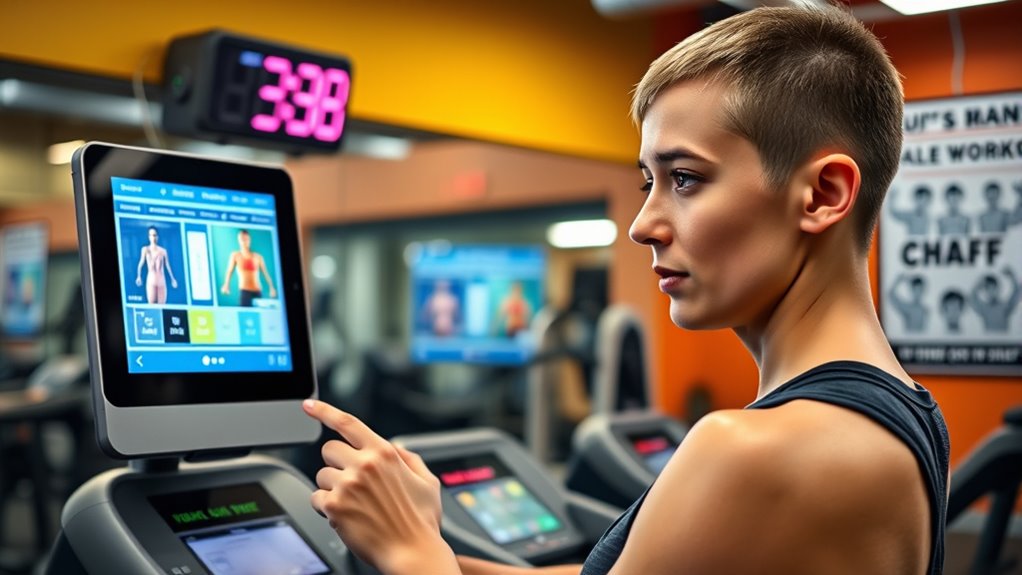
Leveraging technology can substantially boost your workout safety and engagement. Modern hearing aids and wearable technology, like Nuance and fitness trackers, offer real-time audio cues and environmental alerts that keep you aware of your surroundings.
Adaptive audio modes in devices such as Apple AirPods Pro automatically adjust volume to protect your hearing health while maintaining awareness.
Bluetooth-enabled fitness trackers connect seamlessly with hearing aids, synchronizing notifications and safety alerts.
Visual cues and vibration feedback can supplement audio signals, ensuring you stay informed of instructions or safety signals even without sound.
Using captioning apps and real-time transcription services helps you follow workout instructions and communicate effectively in group settings.
Embracing these technologies makes your exercise safer and more engaging, helping you stay motivated and secure.
Understanding and Managing Hearing Devices While Exercising

To stay comfortable and safe during exercise, make sure your hearing devices are lightweight, well-fitted, and securely in place.
Adjust the sound settings to minimize background noise and suit your environment, and consider waterproof options to handle sweat.
Regularly clean your devices so they perform well and keep you focused on your workout.
Securing Hearing Devices Properly
When exercising, making sure your hearing devices stay secure and comfortable is essential to prevent slipping or discomfort. A secure fit helps keep your hearing aids in place, especially during vigorous activity.
To protect your electronics from moisture, use sweat-resistant or waterproof covers designed for active use. Regularly check and adjust the volume settings to a safe level before starting to avoid damage from loud noises.
Consider lightweight, behind-the-ear or in-the-ear models optimized for active lifestyles to enhance stability.
After your workout, inspect your hearing devices for damage or debris, cleaning them according to manufacturer instructions. Properly securing your hearing aids and ensuring moisture protection keeps them functioning well and comfortably through every workout.
Managing Sound Environments
Securing your hearing devices during exercise is just the first step; managing the sound environment around you helps guarantee clear communication and safety. Pay attention to background noise that can interfere with your hearing devices, especially in loud settings like gyms.
Use customizable sound settings on your devices to reduce background noise and focus on important sounds, such as instructions or alerts. Consider all-in-one solutions like Nuance, which combine hearing aids with smart glasses for better environmental awareness.
Wearing earplugs designed for hearing aid users can protect your hearing in noisy environments without losing access to your devices. After exercising, check and clean your hearing devices to prevent sweat or debris buildup, ensuring they function properly and maintain ideal sound clarity in various sound environments.
Building a Supportive and Inclusive Fitness Community
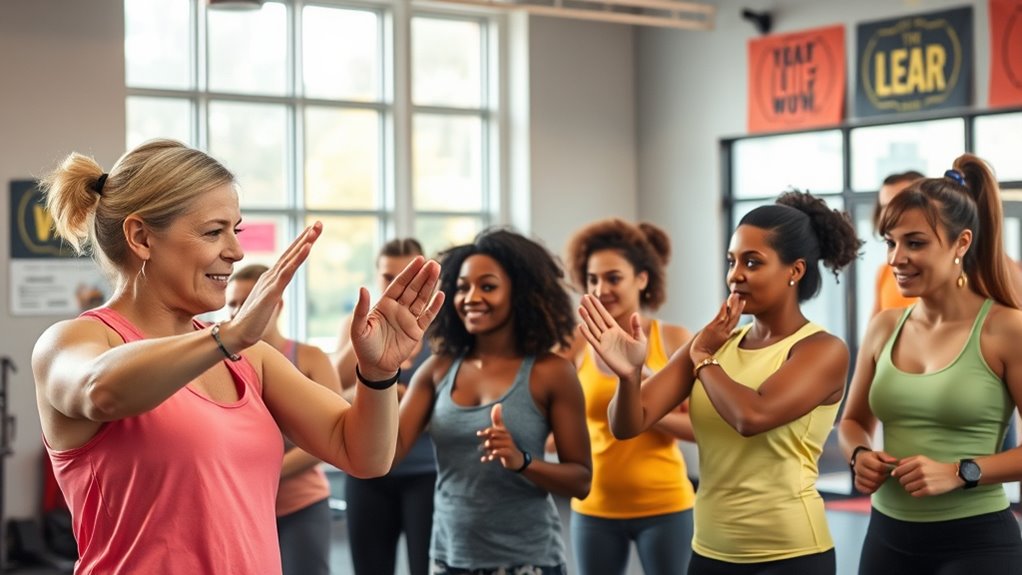
Building a supportive and inclusive fitness community requires intentional efforts to guarantee deaf individuals feel welcomed and engaged. You can foster this environment by promoting deaf awareness and implementing effective communication strategies.
For example, using visual cues, demonstrations, and sign language support makes instructions clearer. Incorporate resources like deaf awareness cards to encourage understanding and interaction. Training staff and group leaders on deaf awareness enhances safety and engagement.
You should also:
- Promote awareness campaigns and partner with organizations like UK Deaf Sport
- Ensure accessible facilities and equipment
- Foster peer support networks
- Use visual signage and clear communication methods
Frequently Asked Questions
What Are the Physical Activities for Deaf People?
You can enjoy a variety of physical activities, such as walking, swimming, yoga, resistance training, and team sports.
With proper communication adaptations like visual cues, demonstrations, and written instructions, you stay engaged and understand the exercises.
Adaptive sports programs also offer tailored activities that foster inclusivity.
Participating in these activities helps improve your health, coordination, and social connections while ensuring a fun, accessible experience.
What Is the Best Exercise for Hearing Loss?
When facing challenges with hearing, you might wonder which exercises can help. The best approach is a mix of cardiovascular activities like walking or swimming, which boost blood flow to your ears, and balance-focused practices like yoga or tai chi to improve coordination.
These exercises not only support your hearing health but also enhance stability and confidence. Always check with a healthcare professional to personalize your routine for peak benefits.
What Do Deaf People Struggle With?
You might find that deaf individuals struggle with communication barriers, making it hard to understand instructions and connect socially during activities.
Safety can also be a concern since they may miss auditory cues like alarms or signals.
Limited access to visual or tactile prompts can decrease motivation and participation, especially in noisy or unfamiliar environments.
These challenges can lead to feelings of exclusion, lowering confidence and making it harder to stay engaged in various activities.
What Are Some Fun Activities for Deaf Students?
You can explore fun activities like sign language dance classes, which combine movement and visual communication, making exercise enjoyable.
Wheelchair basketball and relay races with visual cues promote inclusion and active fun.
Engaging in visual arts or drama allows you to express yourself creatively without relying on hearing.
Non-verbal games like chess or hopscotch keep you socially connected and entertained.
Technology-based activities like virtual reality or interactive apps also make learning and playing exciting and accessible.
Conclusion
Remember, your fitness journey is like steering a vibrant mural—each bold stroke reflects your unique strengths. When I first started working out with deaf friends, I realized that with the right visual cues and support, barriers fade like fog. Embrace adaptive strategies and technology, turning obstacles into opportunities. Your determination paints a masterpiece of resilience and inclusivity, proving that with the right tools, you can overcome any challenge and thrive in your fitness pursuits.

